10 Glide Apps Alternatives and How to Choose Yours
Read Time: 12 minutes
Posted on March 4, 2024

Many creatives, IT leaders, professionals, and companies are on the lookout for Glide alternatives that pack a bit more punch, scale up as needed, or maybe just fit the budget better. Let’s dive into why Glide is a heavyweight in its own right and why, sometimes, you might need to tag in a different contender.
What is Glide?
At its core, Glide allows you to create apps without needing code. It’s designed with ease of use in mind, making it a darling among small business owners, educators, and anyone else looking to make an app without diving into the deep end of coding.
One of its main selling points is that you can easily use spreadsheets as a data source. That’s right – you can turn your Google Sheets into slick, user-friendly mobile apps. Its key selling point? Speed. Glide lets you whip up an app almost as quickly as you can fill out a spreadsheet.
Who uses Glide?
Glide’s simplicity and cost-effectiveness have made it a go-to solution for a diverse group. Small business owners use it to create internal tools or customer-facing apps without breaking the bank.
Educators find it handy for building educational resources or interactive class projects. Non-technical entrepreneurs, thrilled at the prospect of bringing their app ideas to life without coding, are also frequent flyers. Basically, Glide is for anyone who wants to create an app quickly and easily without needing a computer science degree.
Why Would You Need a Glide Alternative?
As much as Glide simplifies app creation, it’s not the end-all solution for every scenario. Many companies, and especially their IT leaders, are scouting for alternatives for several reasons. Maybe their projects have outgrown Glide’s capabilities, needing more advanced functionalities, or perhaps they’re seeking better integration options with other tools and services.
Customization is another biggie – the freedom to tailor every nook and cranny of an app can be crucial for some projects. Then there’s scalability and data security – essential considerations for businesses as they grow. Glide is fantastic, but when your app needs to climb to the next level, it’s smart to know what other tools are out there, ready to lend a hand.
Some of the key reasons teams might start looking for a Glide alternative include:
- Seeking more advanced functionalities: Sometimes, the simplicity of Glide can be its Achilles’ heel. Projects requiring more sophisticated features or complex logic may find Glide’s capabilities limiting.
- Need for better integration capabilities: In a world where apps rarely operate in isolation, the ability to seamlessly integrate with other tools, databases, and services is paramount. Glide’s integration options might not always fit the bill for more complex ecosystems.
- Desire for deeper customization: While Glide offers a user-friendly way to create apps, its customization options are somewhat constrained. Teams looking to deeply customize the app’s look, feel, and functionality often seek more flexible platforms.
- Scalability concerns: As projects grow in size and complexity, they often require a platform that can scale with them. Glide’s model, perfect for quick deployments and smaller apps, might not suit rapidly expanding projects.
- Data security and compliance needs: For businesses in industries with strict data protection and compliance requirements, Glide’s approach might not provide the level of security or control needed. Alternatives offering enhanced security features and compliance certifications become necessary.
- Cost-effectiveness for larger teams: Glide’s pricing model, while competitive for small to medium-sized projects, can become costly as the number of users or the scale of the app increases. Alternatives with more scalable pricing models may offer better long-term value.
Exploring alternatives to Glide is not about finding its replacement but about discovering tools that align more closely with the evolving needs of your projects and organization. Whether it’s for more complex app development, enhanced integration, or specific security requirements, the tech landscape is rich with options ready to explore.
10 Glide Alternatives
In the quest for the perfect app-building platform, variety is the spice of life. While Glide offers a unique approach to turning spreadsheets into apps, there are numerous other platforms out there, each with its own set of strengths and weaknesses. Here’s a look at 10 alternatives to Glide, offering a range of functionalities, pricing models, and features that cater to different needs and preferences.
1 Fliplet

Fliplet stands out as an exceptionally user-friendly no-code platform, especially favored by businesses and enterprises for creating custom apps. Its forte lies in enabling non-technical users to produce professional-grade mobile and web applications swiftly, catering to a broad spectrum of uses from internal communications and operations to customer-facing apps. Fliplet prides itself on its versatility, offering pre-made solutions alongside the capability for deep customization.
- Advantages:
- Highly intuitive interface
- Offers a wide range of customizable solutions suited for various business needs
- Exceptional support and onboarding process, ensuring users can maximize the platform’s potential from day one
- Strong focus on enterprise needs, including enhanced security features, integrations with existing business systems, and compliance with data protection standards
- Disadvantages:
- Slight learning curve
- Might offer more features than needed for very simple or personal app projects.
- Pricing: Offers 3 free web apps to begin, with paid plans offering extra functionality (starting from $9.99 per month) and custom pricing for enterprise-level customers
- Key Features:
- Drag-and-drop interface, simplifying the design and development process
- Comprehensive suite of integrations with popular business tools like Salesforce, SharePoint, and more
- In-built analytics to monitor app performance and user engagement
- Advanced security measures, including role-based access control and encryption, to protect sensitive data
2 Adalo
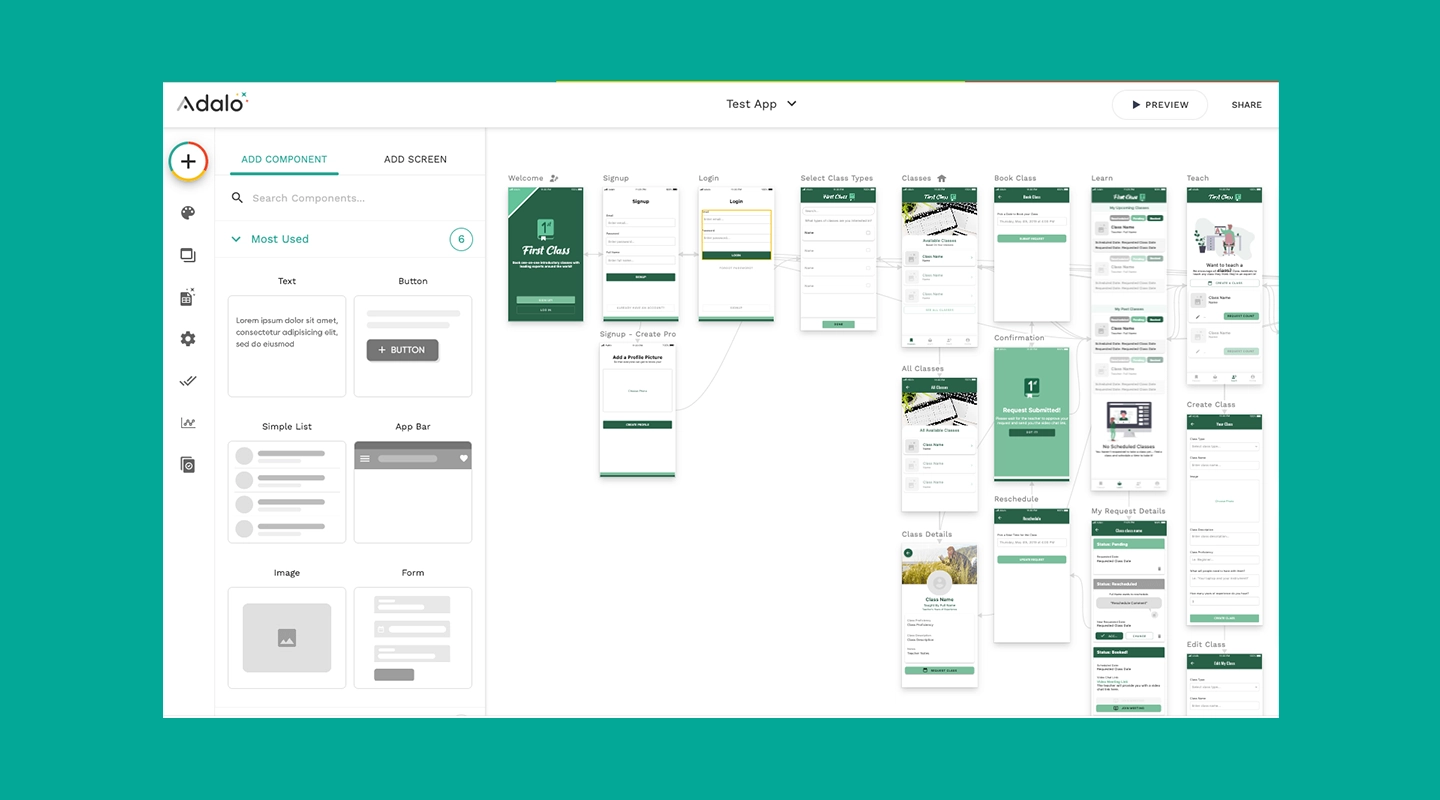
Adalo is a no-code platform that makes app creation as easy as piecing together a puzzle. It’s designed for users who want to build both mobile and web apps with a strong focus on design and user experience.
- Advantages:
- Intuitive drag-and-drop interface
- Strong focus on design and UX
- Allows for the creation of complex apps without coding
- Disadvantages:
- Higher learning curve compared to Glide
- Limited free plan
- Pricing: Free plan available, paid plans start at $36 per month
- Key Features:
- Custom actions and workflows
- Integration with external APIs and services
- User authentication and database management
3 AppSheet

Owned by Google, AppSheet offers a seamless way to create apps directly from Google Sheets, Excel, or a form, emphasizing data-driven applications.
- Advantages:
- Deep integration with Google Workspace and Microsoft Office products
- Robust data manipulation and automation features
- Strong community and support resources
- Disadvantages:
- Can be complex for beginners
- Limited design customization in the free tier
- Pricing: Basic plan starts at $5 user/month and goes up from there
- Key Features:
- Data-driven app creation
- Automated workflows and reporting
- Multi-platform support (iOS, Android, web)
4 Bubble
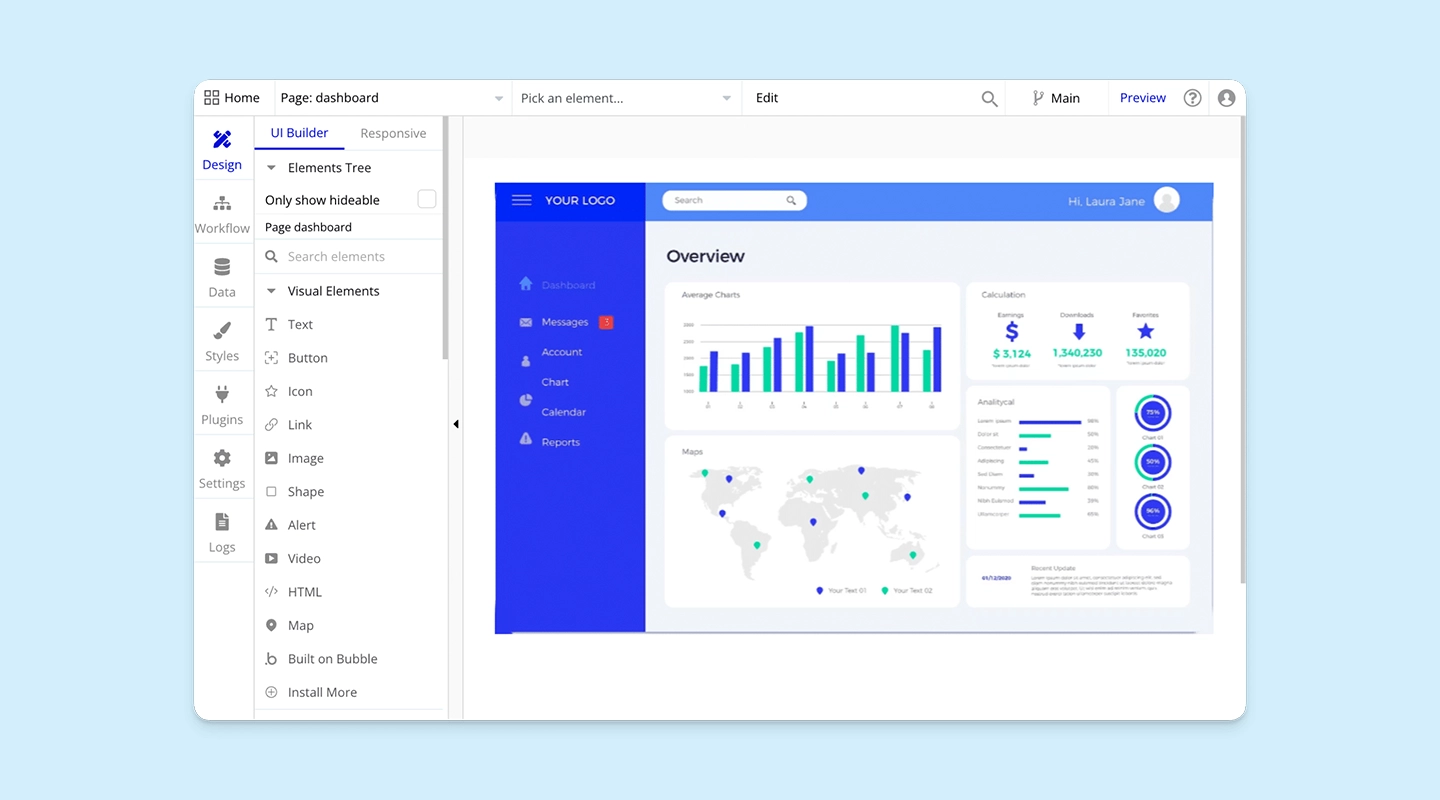
Bubble is a powerful no-code tool that allows users to build web applications ranging from simple prototypes to complex platforms with scalable features.
- Advantages:
- Highly customizable and flexible
- Supports complex functionalities like payment processing
- Large plugin marketplace
- Disadvantages:
- Steep learning curve for complex features
- Performance can be an issue for large-scale apps
- Pricing: Free plan available, paid plans start at $29 per month
- Key Features:
- Visual programming interface
- Extensive database and API integrations
- Responsive design capabilities
5 Thunkable

Thunkable enables anyone to create beautiful and powerful mobile apps without writing a single line of code, focusing on drag-and-drop components.
- Advantages:
- Cross-platform app creation (iOS and Android)
- Extensive library of pre-built components
- Easy to use for beginners
- Disadvantages:
- Apps can look generic without customization
- Limited control over complex backend processes
- Pricing: Free plan available, paid plans start at $13 per month
- Key Features:
- Drag-and-drop UI builder
- Real-time testing on devices
- Access to device-native features
6 SAP Build Apps
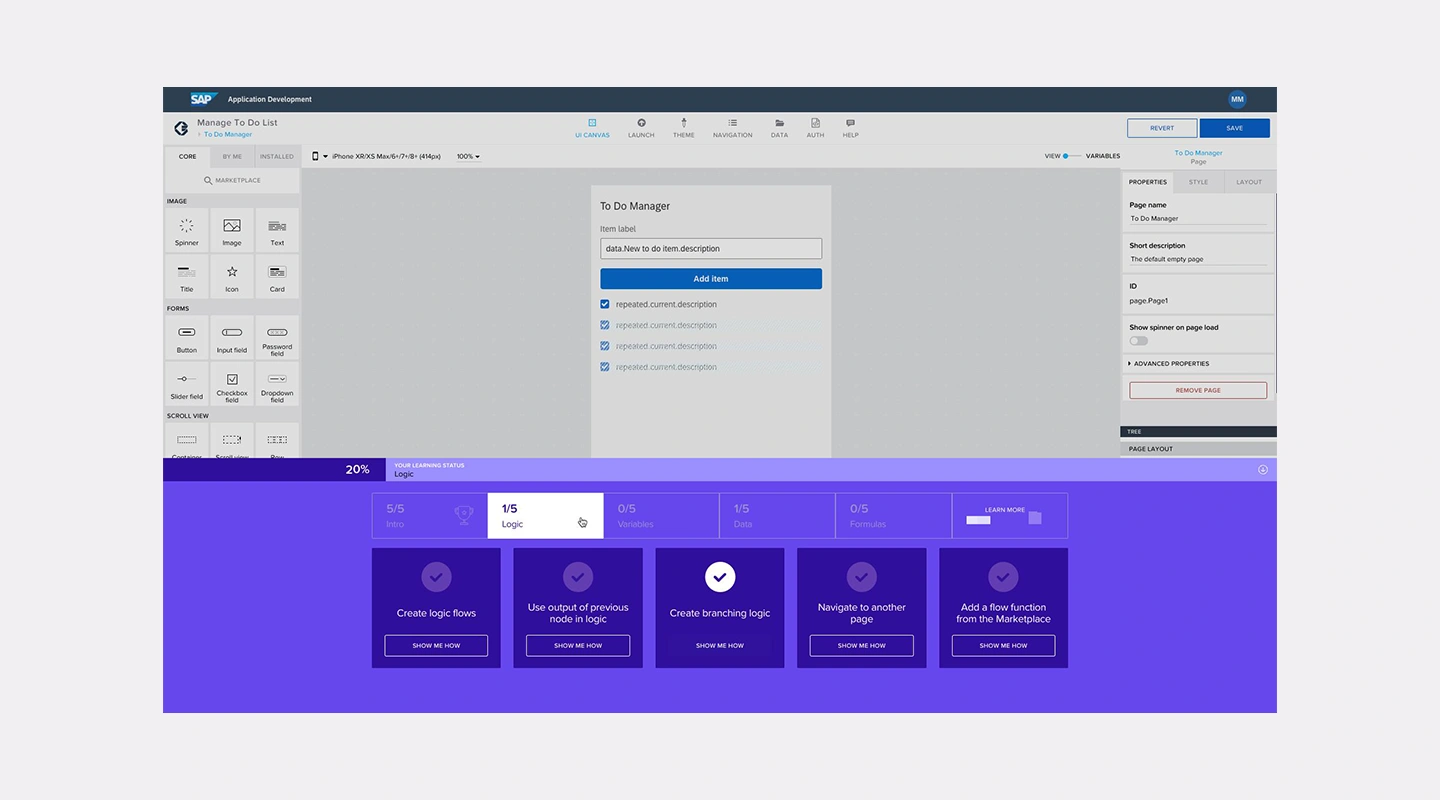
SAP Build Apps is a professional no-code platform that caters to enterprises, offering extensive customization and scalability.
- Advantages:
- Highly scalable for enterprise use
- Rich set of UI components for fully customized apps
- Integration with SAP
- Disadvantages:
- Can be overwhelming for complete beginners
- Non-enterprise customers need to look elsewhere
- Pricing: Highly expensive at $13,116 for lifetime access — but optimized for enterprises that can afford this
- Key Features:
- Logic flows for app functionality
- REST API integrator
- Advanced security features
7 Zoho Creator

Zoho Creator is a low-code platform that excels in creating apps quickly and efficiently, with a strong emphasis on business applications and data management.
- Advantages:
- Deep integration with the Zoho ecosystem
- Robust data management and automation tools
- User-friendly interface for non-developers
- Disadvantages:
- Limited customization for free plans
- Learning curve for advanced features
- Pricing: Plans start at $14 user/month
- Key Features:
- Drag-and-drop interface
- Pre-built application templates
- Extensive reporting and analytics tools
8 Microsoft Power Apps
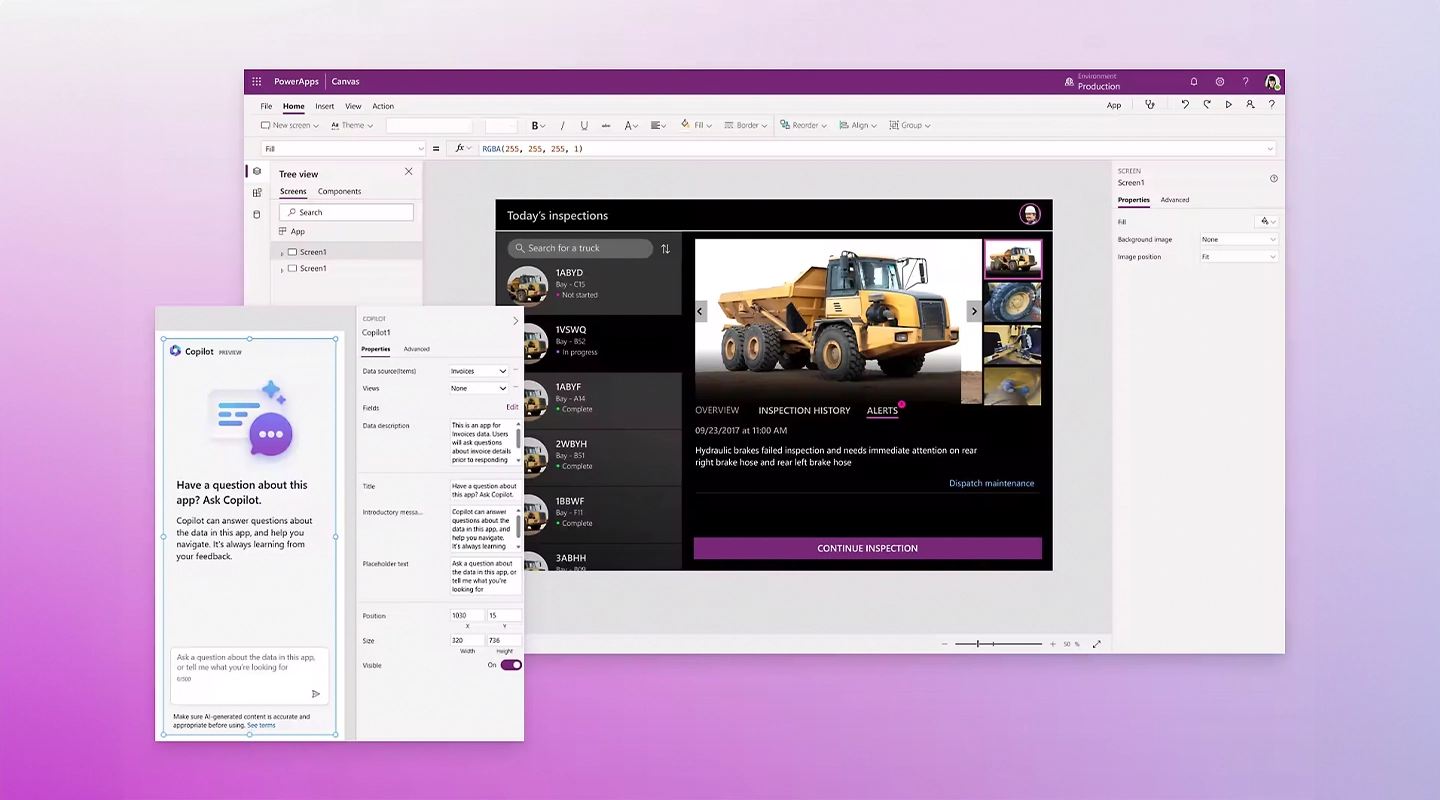
Part of the Microsoft Power Platform, Power Apps is designed to build custom business apps. It integrates seamlessly with various Microsoft products and services, making it a strong candidate for enterprises entrenched in the Microsoft ecosystem.
- Advantages:
- Deep integration with Microsoft 365, Dynamics 365, and Azure
- AI Builder for implementing AI functionalities
- Strong enterprise-level security and compliance
- Disadvantages:
- More expensive for smaller teams or projects
- Can be complex for users unfamiliar with the Microsoft ecosystem
- Pricing: Can fold into Microsoft Suite plans, Premium begins at $20 per month
- Key Features:
- Pre-built templates for rapid app development
- Custom connectors to integrate with external data sources
- Robust workflow automation with Power Automate
9 OutSystems
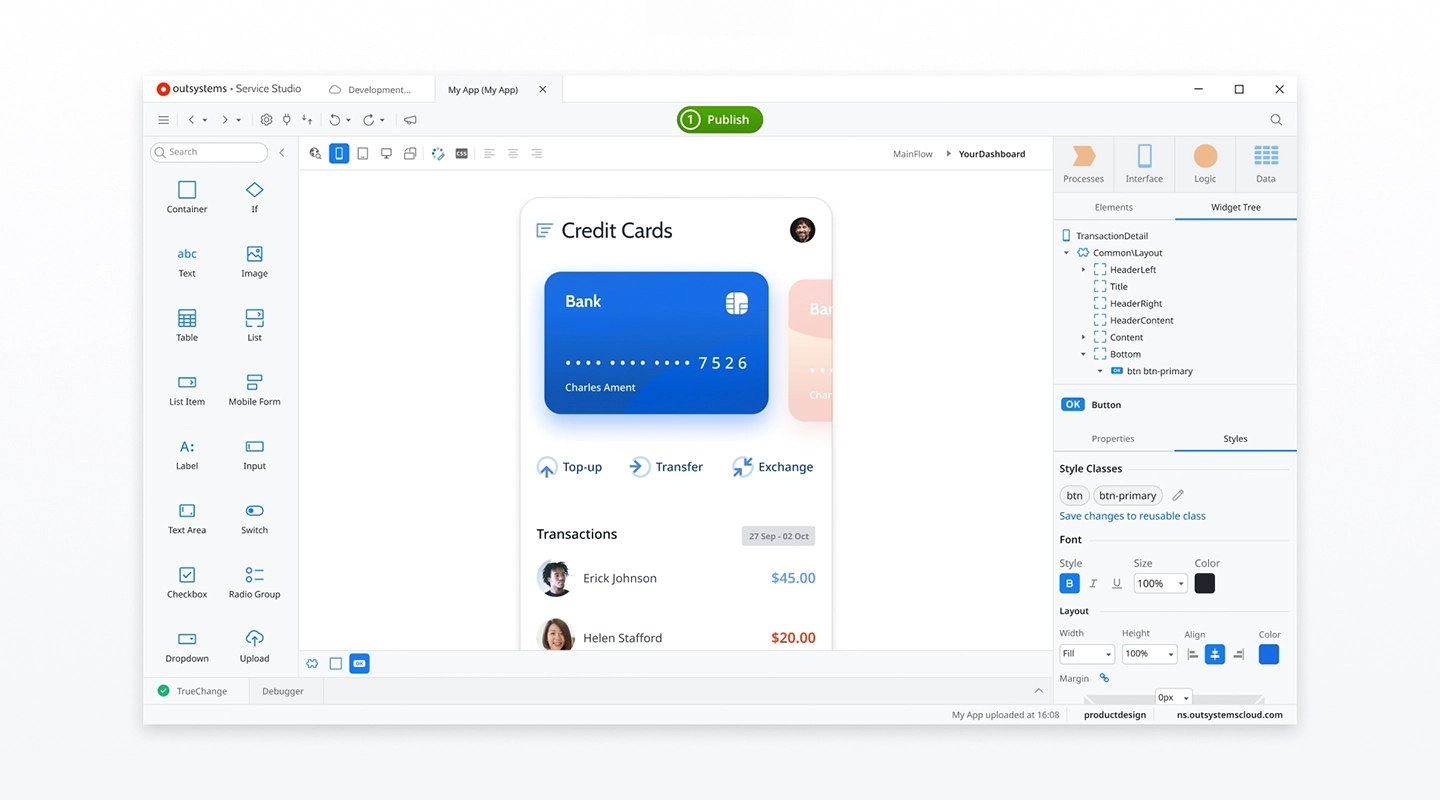
OutSystems is a low-code platform that enables rapid application development, offering a wide range of functionalities for building complex, scalable applications suitable for enterprises.
- Advantages:
- Supports extensive application complexity and scalability
- Strong focus on security and governance
- Large ecosystem of integrations and add-ons
- Disadvantages:
- Pricing can be prohibitive for small businesses
- Steeper learning curve due to its extensive features
- Pricing: Single app is free but it jumps up to $1,513 per month billed annually for multiple apps
- Key Features:
- Drag-and-drop UI and logic builder
- Real-time performance monitoring
- Automated testing and deployment tools
10 Makerpad
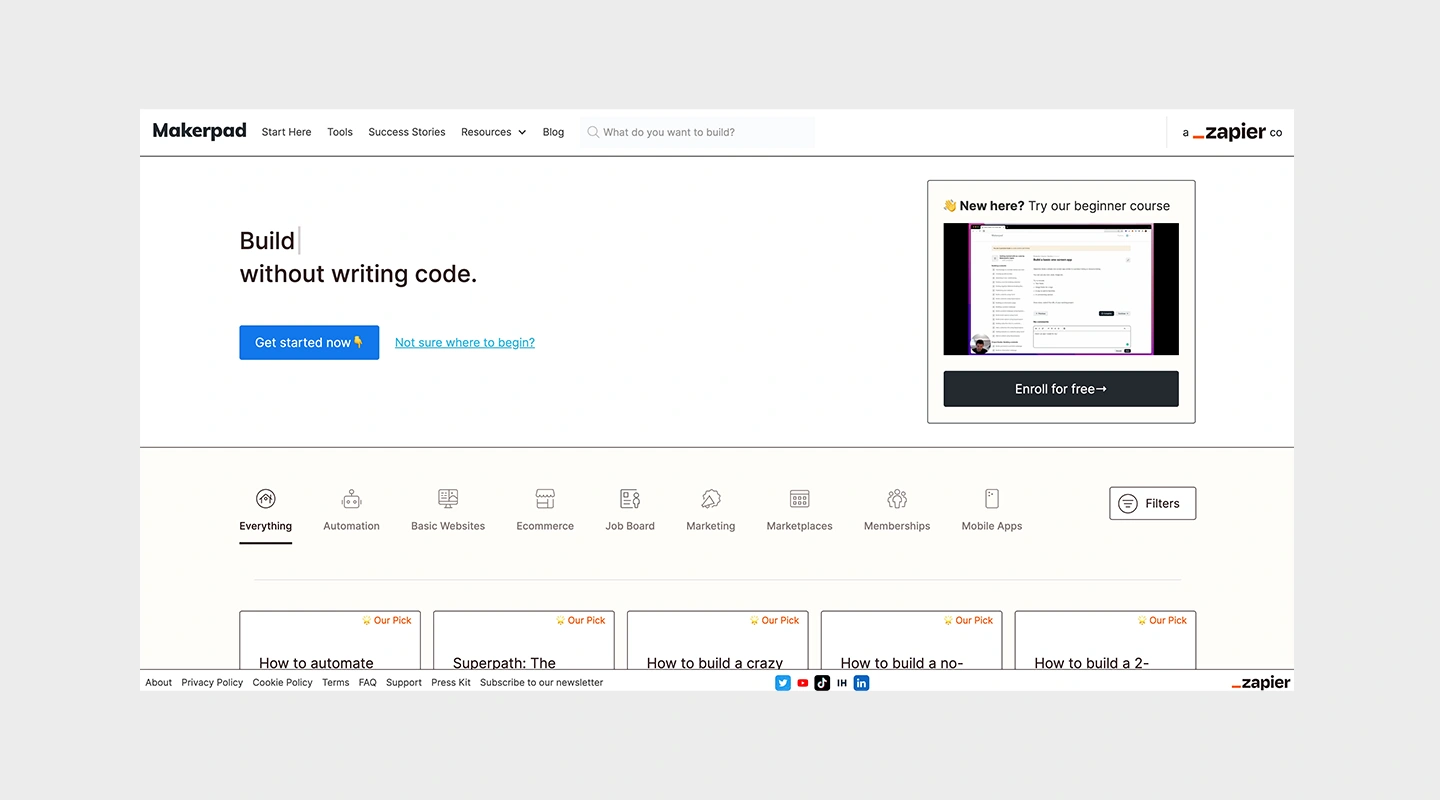
Makerpad is a no-code platform that focuses on teaching and providing tools for building digital projects without code. It’s as much an educational resource as it is a tool, ideal for individuals and businesses looking to upskill their team.
- Advantages:
- Extensive tutorials and resources for learning no-code development
- Community support for troubleshooting and inspiration
- Flexibility to integrate with numerous no-code tools
- Disadvantages:
- Requires a subscription to access most resources and tools
- More of a learning platform than a standalone app builder
- Pricing: One-time payment starts at $600 and enterprise support goes up to $3,000 a year
- Key Features:
- Access to a wide range of no-code tools and integrations
- Community-driven projects and collaborations
- Workshops and tutorials from industry experts
Free Glide Alternative
With no-code app development, finding a robust free alternative to Glide that doesn’t skimp on functionality is a tall order. While Fliplet stands out for its enterprise-grade features and ease of use, another notable contender for those on a shoestring budget is Thunkable. Thunkable distinguishes itself with its cross-platform capabilities, enabling the creation of apps for both Android and iOS without writing a single line of code.
Thunkable excels with its drag-and-drop interface, simplifying the app development process for beginners and seasoned developers alike. Users can leverage a wide array of components and extensions to add sophisticated features to their apps.
The main limitation, similar to other free platforms, lies in the complexity of projects one can undertake without upgrading to paid plans. However, for individuals and small businesses aiming to launch straightforward, functional apps, Thunkable offers substantial value, providing a solid foundation without upfront costs.
Fliplet vs Glide

When it comes to choosing between Fliplet and Glide, the decision hinges on the specific needs and goals of your project. Both platforms offer unique advantages, but Fliplet often emerges as the superior choice for several key reasons.
Basics:
- Glide is celebrated for its simplicity and speed, allowing users to create apps directly from Google Sheets. It’s particularly appealing for quick prototypes and small-scale projects.
- Fliplet outshines with its comprehensive feature set, designed to meet the nuanced demands of small and enterprise applications alike, including advanced security protocols, a plethora of integrations, and extensive customization options.
Major Appeal:
- Glide’s primary strength lies in its user-friendly interface and rapid development cycle, making it ideal for users with limited technical skills or those needing to quickly validate app concepts.
- Fliplet offers a broader spectrum of advantages, particularly for businesses and organizations looking for a more robust solution. Its ability to produce sophisticated, secure, and highly customizable apps makes it the preferred choice for those aiming to deploy professional-grade applications.
Pricing:
- Glide follows a freemium model, making it an attractive option for individuals or small projects. However, scaling up or accessing more advanced features requires moving to its paid plans.
- Fliplet has flexible pricing that gives you affordable options at any level — from those who want to play around with their first app for free to those enterprises looking to create a suite of apps for their organization and its customers.
For businesses and organizations prioritizing scalability, security, and customization in their app development projects, Fliplet consistently stands out as the better option. Its ease of use and suite of enterprise-level features combine with stellar support and integration capabilities. That positions Fliplet as the go-to platform for those looking to create impactful, professional apps that Glide simply cannot match in complexity and polish.
What Features to Look for When Looking for Alternatives to Glide

When exploring alternatives to Glide, users should prioritize a set of core features that align with their strategic goals and operational needs. These features ensure that the chosen platform not only meets current requirements but also supports future growth and adaptation. Key aspects to consider include:
- Customization flexibility: The ability to tailor the app’s appearance, functionality, and user experience to fit the unique brand and operational needs of a business is crucial. Look for platforms that offer extensive customization options, from the UI/UX design to the backend logic.
- Integration capabilities: Seamless integration with existing systems (CRM, ERP, databases) and third-party services enhances the app’s functionality and ensures smooth data flow across different business operations. A platform that supports a wide range of integrations can significantly extend an app’s capabilities.
- Scalability: The chosen platform should be able to accommodate growth in users, data, and transaction volume without compromising performance. Scalability is key to supporting the evolving needs of a business.
- User interface: An intuitive, user-friendly interface for both the app developers and the end-users is essential. For developers, this means ease of use in the app-building process. For end-users, it translates to a pleasant and efficient app experience.
- Support: Robust customer support and an active community can greatly enhance the app development experience. Look for platforms that offer comprehensive documentation, responsive support teams, and an engaged user community.
What do IT Teams Look for When Choosing a Glide Alternative?
When selecting a Glide alternative, IT teams delve deeper into the specifics, assessing platforms based on criteria that ensure the chosen solution can meet the technical, operational, and compliance standards necessary for successful deployment and maintenance. These criteria include:
- Technical support: Access to knowledgeable and responsive technical support is vital, especially for complex projects or when integrating the app with existing systems. It helps in resolving issues promptly and can significantly reduce downtime.
- Data security measures: The platform must offer robust security features, including data encryption, user authentication, and access controls, to protect sensitive information and ensure compliance with data protection regulations.
- Compliance with industry standards: Depending on the industry, certain compliance standards (such as GDPR, HIPAA, or SOC 2) must be adhered to. The platform should facilitate compliance, not complicate it.
- Collaboration within teams: Features that support collaboration, such as version control, role-based access, and real-time co-editing, are essential for teams working on app development. They help streamline the development process and reduce errors.
- Custom code capabilities: While no-code platforms offer many advantages, the ability to add custom code can be a significant benefit for addressing unique requirements or integrating complex functionalities.
Summary
While Glide offers a straightforward and accessible path to app development, it’s not a one-size-fits-all solution. Teams have a wide range of alternatives to consider, each with its own set of features, advantages, and limitations.
By focusing on customization flexibility, integration capabilities, scalability, user interface, support, and specific criteria like technical support, data security, compliance, team collaboration, and custom coding capabilities, businesses can find a platform that not only matches their current needs but also supports their growth and adapts to future challenges.
We encourage readers to explore the options presented, leveraging the insights provided to select the best fit for their projects.
Glide Alternatives FAQs
What are the cost considerations when choosing a Glide alternative?
Costs can vary widely among no-code platforms, depending on the features, scalability, and support offered. Consider both the immediate and long-term costs, including subscription fees, custom development, and potential increases as you scale.
What is the learning curve for new platforms?
The learning curve can vary. Platforms designed with simplicity in mind, like Glide, tend to have a gentler learning curve, while more complex solutions with extensive customization and integration capabilities may require more time to master.
What are the migration challenges from Glide to another platform?
Migration challenges can include data transfer, re-creating app logic and interfaces, and ensuring integrations work as expected. Select platforms that offer migration tools or support to ease this transition.
How do I ensure the chosen platform supports future growth?
Look for platforms that offer scalability, both in terms of user numbers and data processing capabilities, and that continue to evolve with new features and integrations.




